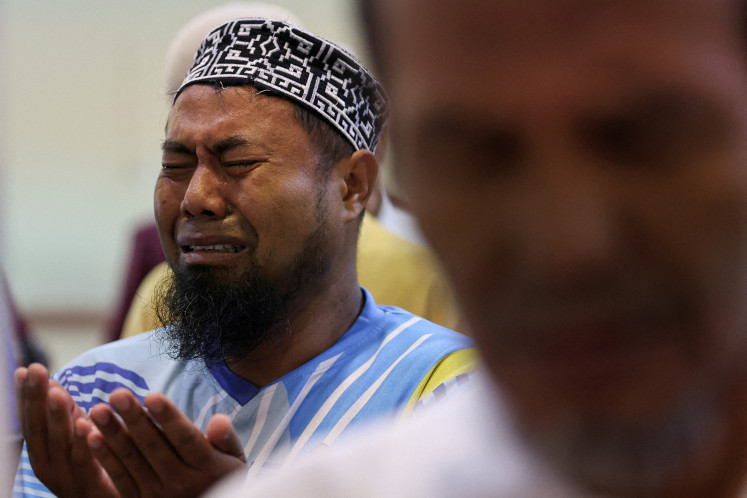Popular Reads
Top Results
Can't find what you're looking for?
View all search resultsPopular Reads
Top Results
Can't find what you're looking for?
View all search resultsArchipelago Belt Aims to Connect Nation
Archipelago Belt Aims to Connect Nation: The Transportation Ministry is working to improve transportation throughout Indonesiaâs archipelago, with a series of inter-island belts combining roads and ferries, to better connect the country
Change text size
Gift Premium Articles
to Anyone
A
span class="caption" style="width: 468px;">Archipelago Belt Aims to Connect Nation: The Transportation Ministry is working to improve transportation throughout Indonesia's archipelago, with a series of inter-island belts combining roads and ferries, to better connect the country.
Unlike most countries, Indonesia does not just comprise of one huge landmass. Its territory encompasses more than 17,000 islands, making the place often a logistical nightmare for those wishing to conduct trade efficiently throughout the archipelago.
One way the government is working to streamline transportation and improve connectivity between its islands is through its ambitious Archipelago Belt project.
Developed under the guidelines of a Transportation Ministry decree from 2010, this program is comprised mainly of three imaginary 'belts' ' the Northern Archipelago Belt, the Middle Archipelago Belt and the Southern Archipelago Belt ' that combine national arterial roads and ferry crossings to connect islands.
'These three belt corridors extend from the western-most parts of Indonesia, to its eastern-most parts. They represent the goal of connecting all of Indonesia's land transportation via ferries,' said Transportation Ministry director general of land transportation Soeroyo Alimoeso.
'Due to the island-based geography of our nation, ferry transportation will play a vital role in affecting the dynamics of development and realizing a system of land transportation between islands.'
Steady progress
The Southern Archipelago Belt was the first to be completed. This belt, which finished construction in December of 2013, connects Indonesia from Sabang, Banda Aceh, Bakauheni, Merak, Ketapang, Gilimanuk, Padang Bai, Lembar, Kayangan, Pototano, Sape, Labuan Bajo, Larantuka, Waiwerang, Lewoleba, Baranusa, Kalabahi, Ilwaki, Wonreli, Serwaru, Moa, Lakor, Sermata, Tepa, Saumlaki, Larat, Tual, Dobo, Timika, Agats and Merauke.
The entire belt connects 16 islands and is made up of 5,330 kilometers worth of road and 1,600 miles worth of sea. It is being serviced by 115 ferry boats on 11 sea-land crossroads in Indonesia.
According to Deputy Transportation Minister Bambang Susantono, this southern belt is an important artery in the Indonesian economy. Some 80 percent of the nation's population lives within this entire beltway. As a result, they provide some 80 percent of the country's regional gross domestic product (GDP). 'This southern belt is one of Indonesia's economic strengths,' Bambang said in an official release.
As for the Middle Archipelago Belt, it is set to be fully completed by the year's end. It covers a total of around 3,800 kilometers and goes through 12 provinces ' Sumatra, Bangka Belitung, West Kalimantan, Central Kalimantan, South Kalimantan, East Kalimantan, West Sulawesi, Central Sulawesi, South Sulawesi, North Maluku, Maluku and West Papua. This belt also covers eight crossings, including one between Fakfak in West Papua and Wahai in Maluku.
The last of these three roads, the Northern Archipelago Belt, is scheduled for completion in 2015. Its reach will include Riau, Sintete, Tarakan, Toli Toli, Amurang, Bitung, Ternate, Patani, Sorong, Manokwari, Biak, Sawai and Jayapura.
Some 85 percent of the southern belt is already fully commercial and has no state interference, aside from it setting timetables and the number of ships it is allowed to serve. The middle and northern belts are still state subsidized. One of the commercial ports is the Merak-Bakauheni crossing. It has five docks, covers 15 miles of sea and is being served by 42 passenger ships.
Group support
Helping the Transportation Ministry in this nationwide endeavour is state-owned seaport operator PT ASDP Indonesia. It is serving as one of the service-providing ship operators in all three of the archipelago belts.
Local administrations are also lending a helping hand in the project, in the form of providing infrastructure and operational implementation. In terms of infrastructure, local administrations are supplying the Transportation Ministry with land for seaports, terminal buildings and access roads that lead to ports. As for aid with operations, these administrations have prepared human resources for in-the-field work.
In addition, local administrations are also responsible for maintenance at the various port infrastructure points. All human resources assigned to belt-related jobs receive wages from local budgets. The central government is giving support with funding for infrastructure maintenance and for the development of supporting facilities. It is also giving subsidies for the various crossings.
Future prospects
The Transportation Ministry is already planning ahead. It wants to push the limits of its inter-island connectivity project.
'All islands have to be served. We hope that in the near future, we can continue to develop the country's system of ferry transportation. For example, if we are currently serving two ferry schedules per week, we hope to be able to increase this to four times per week and even regularly per week, if the demand exists, which would also mean adding to our armada,' Alimoeso said.
Likewise, if the demand for better facilities comes around, the ministry will also improve the infrastructure. Another aspect subject to change depends on the weather. The ministry said that it will pay close attention to changes in conditions and make adjustments on ship sizes that can withstand harsh weather conditions.
The government itself also plans to aid the connectivity effort by complementing the national roads with improved train transportation.
'All of this is in the name of communication, communication between islands and communication for trade within the country's indoor system to prevent discrepancies from one city to another,' Alimoeso said.










